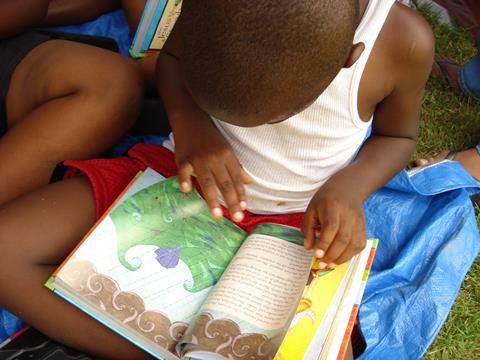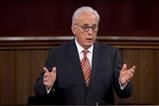If we want our children to understand why scripture is relevant to their lives, we need to stop dumbing it down, says Krish Kandiah

What use is a manuscript from thousands of years ago in an age when a child learns their ABCs with Amazon, Brexit and Covid?
Is the Bible boring and irrelevant? Does it have anything to say about the hot topics that our kids really care about, such as gender identity, the refugee crisis, mental health issues and climate change?
The Bible doesn’t come with expansion packs, in-app purchases, same-day delivery or social media spaces. In a fast-paced, future-minded global world, what use is a book that centres on one man who lived 2,000 years ago somewhere in the back of beyond? Is it any wonder that we are seeing fewer and fewer children in our churches? Parents and children’s workers are fighting a losing battle. Congratulations Harry Potter, Sunday morning football clubs and Fortnite - you win.
Or is there a different story? In fact, the Bible has plenty to say on those highly relevant topics from consumerism to international relations. It is not afraid to challenge gender stereotypes, mandate climate care, promote healthy relationships or teach critical personal values such as patience, abstinence and self-control. It even goes so far as to tackle thorny subjects such as death, violence, war, pain, loss, guilt and fear.
Sunday school was like my children’s chemistry set, with every dangerous chemical removed
Maybe it is not that the Bible has too little to say to our world today, but that it has too much. There is too much talk of commandments and consequences and too many cautions and challenges. It is sometimes too full-throttle, hot-blooded, cut-to-the-heart honest about how life really is. Could that be why we have been tempted to dumb it down for our children in the past? But in doing so, have we made scripture anaemic, redundant and boring?
It is time to recapture the relevance and vitality of the Bible today. Especially when it comes to passing it on to the next generation. Here are 5 key ways we can make a start in this:
1. Recognise that everyone has a responsibility
To help our children engage with scripture we may have to re-engage with it ourselves. It is much easier to enthuse about something we are enthusiastic about. Whether we are a parent, carer, grandparent, aunt or uncle, children’s worker or just a member of our local church family, we are all responsible for creating a culture of Bible enthusiasm.
My passion for the Bible was initially sparked by my mother, who spent years praying with me at bedtime and sharing the occasional Bible story. Then there was a family friend who sent me my first grown up Bible when I was 9, the Sunday school teacher who went out of her way to make me feel part of the local church I just turned up at on my own one Sunday morning, the schools worker who shared with me how helpful Bible memorisation had been to him in his life and a mentor at university who helped me dig into the scriptures in a theologically rigorous way. From the elderly lady who would send me Bible verses on little notelets, to the many speakers in many churches who communicated passion for their Bibles as much as anything else, there were so many people who kept inspiring me (not forcing me) to open up the book for myself. Any of us - and all of us - can do that for someone else.
2. Rebuild the connections
Too many of us write off the Bible as being disconnected from our lives. As a child, I did the same. I remember reading it and assuming that everyone in it was white because every stained glass window or movie depicted Moses to Mary, Joseph to Jesus as being white-skinned Europeans. I also assumed that everyone in the Bible had lives without drama or trauma because those who had re-narrated the Bible stories had taken out any potentially offensive, difficult or ‘adult’ themes out of the stories.
Sunday school was like my children’s chemistry set, with every possible dangerous chemical combination removed from the box along with any hope of becoming the next Louis Pasteur. These ethnocentric, anodyne approaches to the Bible are dangerous, because they can inoculate children with just enough of a watered-down version of it to make them reject it. In fact, hardly anyone in the Bible is white and all of the characters in it face trauma or temptation in one form or another. It is precisely in those gritty circumstances that we can relate most to them. That is where we can rebuild connections with characters from all around the world that have faced loss, made mistakes, felt inadequate, anxious or turned their back on God.
3. Release the Bible into the wild
From a very young age, my mother was taught to pray before she went to sleep. It was a great habit but the problem was, she wasn’t taught to pray anywhere else. Sadly this is the case for too many children.
The Bible is forced into small corners of our lives – our bedrooms, our classrooms, and whatever space we occupy for an hour on a Sunday morning. But the Bible is so much bigger than that! Since much of the Bible was written in caves, up mountains, behind bars and during long journeys, it seems appropriate to read it in equally diverse and surprising places.
Deuteronomy 6 encourages us to talk about the Bible when we sit at home and when we walk along the road. It is for inside and outside. Let’s discover how to talk about scripture on our family walks, on car journeys and on holiday. Any day of the week, anywhere we go, whatever the weather – we can tell each other Bible stories, work out how the Bible relates to the news of the day, discuss deep theological problems, or share a verse we have learned recently. Release it into the wild and see what happens next.
4. Re-translate the Bible
JB Philips, the biblical scholar, once described his experience of translating the Bible into modern English as akin to rewiring a house with the electricity switched on. It’s a vivid metaphor that expresses the excitement and transforming power of serious engagement with scripture. But Bible translation is not just for linguists. Whenever we re-tell a Bible story in language children can understand, whenever we help them to grasp a Bible truth using illustrations they can relate to, whenever we help them recreate part of the Bible in the form of a picture, a Lego model, a Minecraft landscape, a poem, a comic book, or a piece of art, we are translating the Bible. It is a creative process that builds a bridge from the original to the new; it absorbs our minds, our hearts and our hands. This is powerful in not only forming a love for the Bible but an appreciation of the Creator God who gave us scripture in the first place.
5. Re-think access
My wife and I have recently published Whistlestop Tales: Around the world in 10 Bible stories (Hodder Faith Young Explorers) in order to celebrate the amazing global diversity of the Bible and to help children engage with its relevance to their everyday lives. We loved building those connections, letting our imaginations run wild and translating stories into the style of popular children’s books.
The illustrations help children with dyslexia follow the story. Visual cliff-hangers encourage children to turn the page. Some children are visual learners, others prefer a more hands-on approach. Some like to engage by talking, others by listening. Some have very short concentration spans, others much longer.
My son, who has autism, needs to learn in a very predictable environment. My daughter, who has a different form of communication disorder, needs stories repeated over and over. Every child is different and will see the Bible from their own unique perspective. This means that, while we might be wondering how to best teach them, they will have something to teach us too.
When we help children recreate Bible stories as Lego models or Minecraft landscapes, we are translating it
I believe the Bible is as powerful and relevant as ever. And I believe that children, despite all their video games and social media, can be engaged and enthralled by it. As we set out to inspire them to discover it for themselves, may we learn to approach the Bible like a child too, seeing it with fresh eyes and having our passion re-ignited too.




































